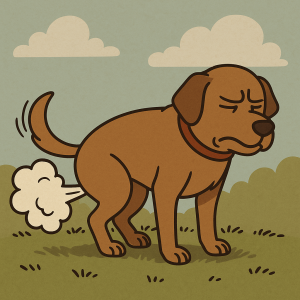28 Everybody Farts – Instructor Guide
Boys, Girls, Grandmas, Grandpas, Dogs, Cats, Hamsters, and Ponies –
Everybody Farts!
Why do we fart? Why do they smell so bad?
Created by O Lebal, A Pettee and M Pringle; members of the University of Minnesota veterinary class or 2027
Instructional Guide
Farting is an everyday occurrence that often leaves those involved laughing and/or embarrassed. The truth is that there shouldn’t be any embarrassment surrounding normal bodily functions and by teaching how and why it occurs can help eliminate any negative stigma. The goal of this lesson is to help students understand why we fart and how it is a natural and unavoidable process.
The purpose of the stomach and intestines is to reduce food into usable energy for the body. During this process the food is broken down into its chemical components, including carbohydrates, protein, cholesterol, and gasses such as methane, nitrogen, and carbon dioxide. The nutrients are taken into the body to be used, while the gas is of no use to the body; yet, it still must have somewhere to go. This causes the body to expel the gas via flatulence, also known as farting.
Intended Grade Level
This lesson is intended for 1st & 2nd grade students, aged 6-8 years old.
Participants need only have a rudimentary understanding of the process their food goes through from the time it is consumed to excretion (mouth – stomach – intestine – rear end). This lesson would be a good supplement to a standard digestion lesson.
Minnesota state standard connection
4.2.1 Students will be able to read and interpret multiple sources to obtain information, evaluate the merit and validity of claims and design solutions, and communicate information, ideas, and evidence in a variety of formats.
3L.4.2.1.1 Obtain information from various types of media to support an argument that plants and animals have internal and external structures that function to support survival, growth, behavior, and reproduction.** (P: 8, CC: 4, CI: LS1)
Learning Objectives
- Students will be able to describe why farting happens and what causes it
- Students will be able to accurately organize the steps of digestion from consumption to excretion
- Students will be able to identify foods that make you fart
Lesson Format
- Estimated Duration: 45 minutes depending on allocated length for activities.
- This lesson is designed to be run by the instructor and to involve a larger group.
This is an understandably humerus topic for elementary students to learn about. To promote focus and engagement throughout the rest of the lesson, start with an activity for students to break out into partners or small groups for a minute or two, and practice making different fart sounds with each other. This will break the ice and allow students a chance to embrace how entertaining farting is, so they can be serious about it throughout the remainder of the lesson.
- As an example please see this teacher blog detailing a lesson called “the Classroom Toot Talk”
- Another resource you may want to consider to have here is the Almost everybody farts book
Once the ice has been broken it’s time to be serious. Reiterate the idea that everybody farts. Ask the class to raise their hand if they have ever farted (you will raise your hand as well). Take a few minutes to lead a discussion for your class explaining that farting is nothing to be embarrassed about. When someone farts, it isn’t nice to draw attention to it, call someone stinky, plug your nose, etc. Farting is normal, and everybody farts!
Once we all feel comfortable, lets continue by watching one of the two videos to introduce why we fart. After, students can read through some of the science behind farting as a group, or indecently. Once they have done that, watch one more video on what happens when we don’t fart.
Activities
Students will sort foods into groups based on whether or not they think they will make them fart or not (beans, onions, fried foods, eggs, meat, broccoli, nuts, lactose products for some people).
Assessment
- Students can work in pairs to put their flashcards in chronological order from consumption to excretion.
- Food > mouth > stomach > digestion > production of gas can make the gut upset or bloated > expulsion of gas – Farting!
- Below are printable flashcards to complete this assessment-of-learning activity.

Common Misconceptions & Challenge Points
- Keeping the students engaged and focused throughout the lesson can pose challenges. Use whatever systems works for you and your classroom to ensure students are learning.
- Finding vocabulary appropriate for this age level without compromising the content.
- Students may have difficulty understanding the difference between why the body needs nutrients but not gases (why gas is a waste product), as well as the difference between carbon dioxide – or methane gas – expelled through farts and exhaled.”
Further Exploration
students can explore why some animals are super-farters (or burpers)
PBS’s video: Cow Burps are Warming the Planet
Other chapters within this textbook may be interesting for students. Some options can be found linked below:


